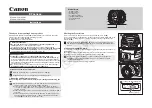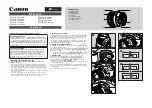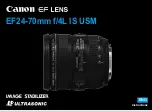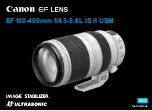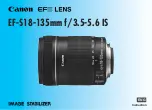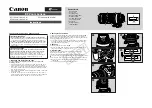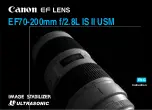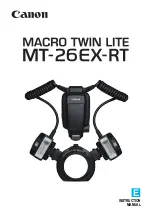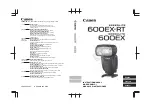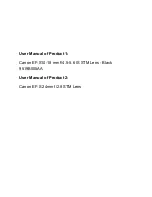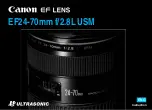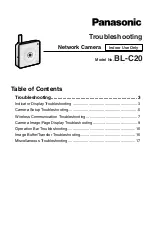
This is a telephoto lens for a single-lens reflex
camera or interchangeable lens mirrorless digital
camera, adopting reflective optics to achieve a long
focal length within a compact body.
1. Name of Each Part
3. T-Mount
⑨
Outer screw
(three locations)
⑩
Outer ring
⑪
Inner ring
You must adjust the position of the T-mount to adjust the
position of the lens. Remove the T-mount to attach rear
filters to the lens.
Use the following procedure to adjust the position of the
T-mount or remove the T-mount:
2. Attaching the Lens to the Camera
Align the indicator marks on the T-mount and the camera,
and then turn the lens until you hear a “click.”
(For attachment and removal, refer to “Attaching the Lens”
and “Removing the Lens” in your camera's manual.)
Check the attached lens for any looseness.
Some cameras must be set up to be to use a manual lens
prior to lens attachment. Set up your camera by referring
to the information provided below. For details, refer to
your camera's manual.
Turn the lens until the distance scale indicator comes to the
top center, and then securely tighten the outer screws
⑨
(three locations) as shown in Fig. 2.
Slightly loosen the outer screws
⑨
(three locations) as
shown in Fig. 2.
*
Do not loosen the screws too much, because it may cause
the inner ring of the T-mount (
⑪
in Fig. 2) to come off.
*
Use a commercially available precision screwdriver to
loosen the screws.
2
1
Remove the T-mount from the lens by turning the T-mount
counterclockwise while holding the lens with the other hand.
Slightly loosen the outer screws
⑨
(three locations) as
shown in Fig. 2.
*
Do not loosen the screws too much, because it may cause
the inner ring of the T-mount (
⑪
in Fig. 2) to come off.
*
Use a commercially available precision screwdriver to
loosen the screws.
2
Take the lens off the camera first.
3
1
Note: If the outer
screws
⑨
are loos-
ened too much, the
inner ring
⑪
may
come off.
If the distance scale indicator mark
(
⑤
in Fig. 1
)
doesn't align at the top center of the lens when it is
attached to the camera, make an adjustment with the
following procedure:
Use the following procedure to remove the T-mount
from the lens:
4. Setting Up the Camera
[Fig. 1 Lens with T-Mount Removed]
[Fig. 1]
[Fig. 2]
Camera
T-mount
As a general guide, the shutter speed should be in a range of
1/500 to 1/1000 on a fine day when the ISO sensitivity is set to
400. If you're using a digital single-lens reflex camera, take your
photos while checking each image on the LCD monitor:
●
The image is too dark: Lower the shutter speed.
●
The image is too bright: Raise the shutter speed.
Set the shooting mode to “M (manual).” On the
α
77 and certain
other models, the non-lens release lock function must be
canceled.
Menu Setup Menu Change the setting for [Release without
Lens] to [Permit].
*
The aperture can't be adjusted in the aperture priority mode.
*
The aperture value isn't displayed under “Exif.”
●
Sony
α
The “M (manual)” mode and “Av (aperture priority)” shooting
mode can be used.
When using the built-in hand-shake correction function, set the
“Lens Focal Length” on the “Focal Length Entry” screen.
*
The aperture can't be adjusted in the aperture priority mode.
*
The aperture value isn't displayed under “Exif.”
●
Pentax
⑨
⑨
⑨
⑩
⑪
10
12
15
20
30
50
100
f
t
M
AC
RO
3
3.5
4
5
6
8
10
15
30
m
1:3
.5
1:4
1
:4.
5
10
12
15
20
30 50 100
f
t
MA
CR
O
3 3.5
4
5
6 8 10
15
30
m
1:3
.5
1
:4
1
:4.
5
10
12
15
20
30
50
100
f
t
M
AC
RO
3
3.
5
4
5
6
8 10
15
30
m
1:3
.5
1:4
1
:4.
5
② ③ ⑤
①
④
⑦
⑥
⑧
(Inside)
⑨
*
The shape of the T-mount varies among the different camera brands.
*
The shape of the T-mount varies among
the different camera brands.
Brightness
Lens construction
Minimum focus distance
Macro magnification factor
Filter diameter
(diameter of filter at rear of lens)
Maximum diameter
Overall length (excluding T-mount)
Weight (excluding T-mount)
F8 (fixed)
2 groups, 6 lenses
1.15 m
1:2.5
67 mm
*
(30.5 mm)
φ
74 mm
82mm
340 g
5. Performance Table
Instruction Manual
3-9-19 Nishi-Ochiai, Shinjuku-ku, Tokyo 161-8570
http://www.kenkoglobal.com
①
Focus ring
②
Distance scale (in feet)
③
Distance scale (in meters)
④
Macro magnification scale
⑤
Distance scale indicator mark
⑥
T-mount adapter (Sold separately)
⑦
T-mount attachment thread
⑧
Filter attachment thread (Inside of rear)
⑨
Filter attachment thread (Front)
Tip
*
Before attaching a filter to the front of the lens, be sure the filter
won't contact the reflective part (black circle) at the center of the front
surface of the lens.
Specifications and exterior views are subject to change without notice for
the purpose of product improvement.
The lens can be used in the “Av (aperture priority)” mode and “M
(manual)” mode.
■
How to use the “Av (aperture priority)” mode
1. Set the exposure mode to “Av.”
2. Correct the exposure compensation if necessary.
If this lens is used with a Canon EOS series camera, the following
operations may be required on some models due to the mecha-
nism of the camera:
• When the lens is attached, the aperture is displayed as “00.”:
No action is needed in this regard.
• A value (e.g., F5 or 6) is displayed as an aperture when the lens
is attached:
Open up the aperture (adjust it to the smallest value).
●
Canon EOS Series
*
This lens can't be used with the EOS-700, 750 and 850
because those cameras have no aperture priority mode (Av) or
manual mode (M).
*
If a conversion lens or an extension tube (ring) is attached, the
camera won't operate normally. Do not combine this lens with
the above items.
*
The Focus Aid can't be used.
*
The aperture can't be adjusted in the aperture priority mode.
*
The aperture value isn't displayed under “Exif.”
The supported exposure modes are limited depending on the
camera model.
Refer to “List of Supported Non-CPU Lenses” or other similar
sections in your camera's manual.
To use this lens with any camera listed above, set the shooting
mode to “M (manual).” The shutter won't release in any other
mode.
*
The shutter speed must be adjusted depending on the condi-
tion in which photographs are taken.
*
Set the focus mode to “MF.”
*
The aperture can't be adjusted in the aperture priority mode.
*
The aperture value isn't displayed under “Exif.”
●
Nikon
D100, D50, D70, D70S, D40, D40X, D60, D80, D90,
D5000, D3000, D3100
The non-lens release lock function must be canceled.
Menu Setup Menu Change the setting for [Release without
Lens] to [Permit].
Any shooting mode can be used, except for those in which
priority is given to the shutter speed. It isn't recommended that
priority be given to the shutter speed (shutter priority mode).
*
In the program mode, aperture priority mode or manual mode,
set the ISO sensitivity to AUTO.
Menu Brightness/Color ISO Sensitivity Set to [AUTO].
*
The aperture can't be adjusted in the aperture priority mode.
*
The aperture value isn't displayed under “Exif.”
●
Sony NEX
(
E-mount
)
Any shooting mode can be used, except for those in which the
shutter speed is given priority (shutter priority mode). It isn't
recommended that priority be given to the shutter speed.
*
When using the program mode, aperture priority mode or
manual mode, set the ISO sensitivity to AUTO.
Setup Menu Exposure/Light Measurement/ISO Set to
[AUTO].
*
The aperture can't be adjusted in the aperture priority mode.
*
The aperture value isn't displayed under “Exif.”
●
Olympus Micro Four-Thirds
The non-lens release function must be set to [ON].
Setup Menu Release without Lens Set to [ON].
Any shooting mode can be used, except for those giving priority
to the shutter speed (shutter priority mode). It isn't recommended
that priority be given to the shutter speed.
*
When using the program mode, aperture priority mode or
manual mode, set the ISO sensitivity to AUTO.
Setup Menu ISO Sensitivity Set to [AUTO].
*
The aperture can't be adjusted in the aperture priority mode.
*
The aperture value isn't displayed under “Exif.”
●
Panasonic Micro Four-Thirds



